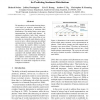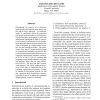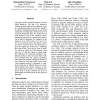51 search results - page 3 / 11 » Learning Word Vectors for Sentiment Analysis |
EMNLP
2007
13 years 9 months ago
2007
Recognizing polarity requires a list of polar words and phrases. For the purpose of building such lexicon automatically, a lot of studies have investigated (semi-) unsupervised me...
EMNLP
2011
12 years 7 months ago
2011
We introduce a novel machine learning framework based on recursive autoencoders for sentence-level prediction of sentiment label distributions. Our method learns vector space repr...
EMNLP
2008
13 years 9 months ago
2008
Determining the polarity of a sentimentbearing expression requires more than a simple bag-of-words approach. In particular, words or constituents within the expression can interac...
EMNLP
2009
13 years 5 months ago
2009
This paper studies sentiment analysis of conditional sentences. The aim is to determine whether opinions expressed on different topics in a conditional sentence are positive, nega...
LTCONF
2007
Springer
14 years 2 months ago
2007
Springer
Recent work in sentiment analysis has begun to apply fine-grained semantic distinctions between expressions of attitude as features for textual analysis. Such methods, however, r...



